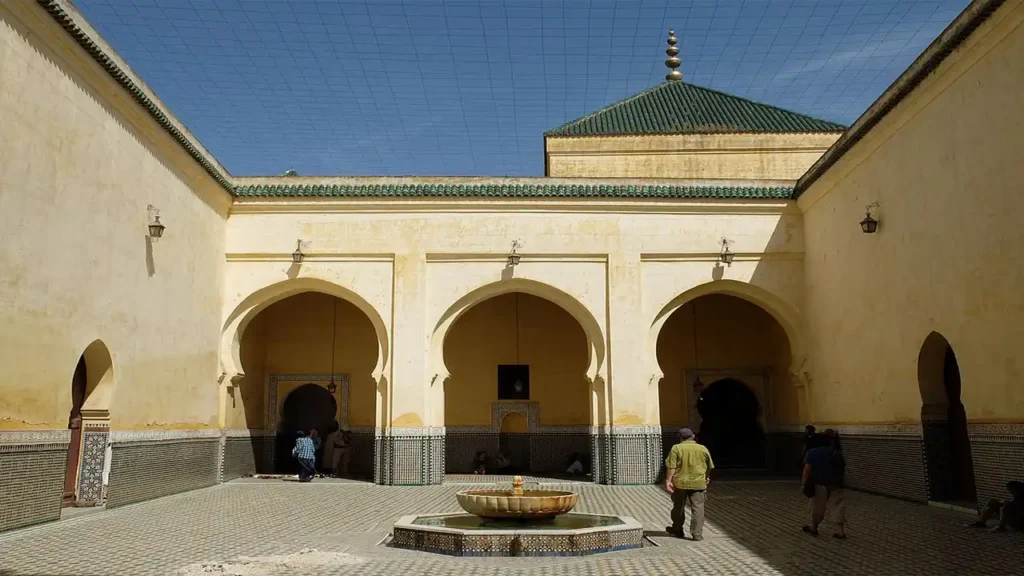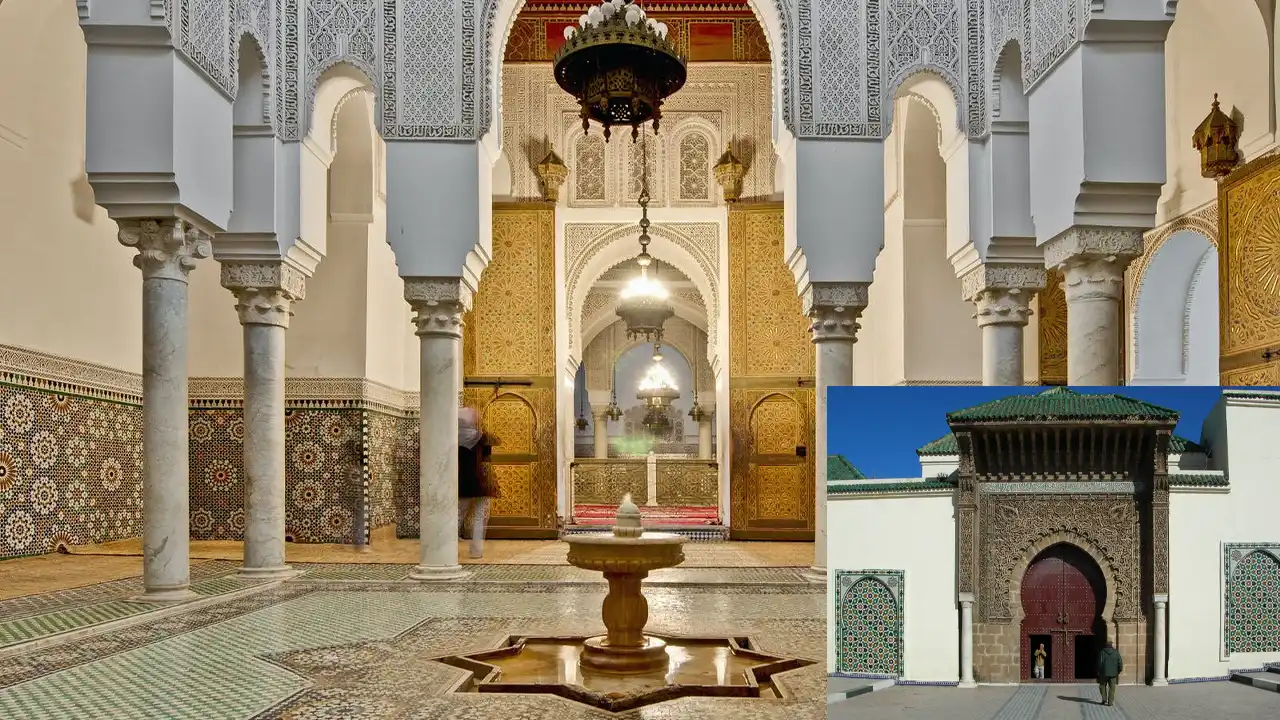Secrets of the Mausoleum of Moulay Ismail: Meknes’ Imperial Gem
The Mausoleum of Moulay Ismail is a treasure of Meknes, blending historical significance with architectural beauty and spiritual reverence. Nestled in the heart of this imperial city, it serves as the final resting place of Sultan Moulay Ismail, one of Morocco’s most influential rulers. His transformative reign (1672–1727) left an indelible mark on the nation, uniting its territories and turning Meknes into a showcase of grandeur, earning the city its title as the “Versailles of Morocco.”
Visiting this mausoleum offers more than just a journey into the past—it provides a deeper connection to Moroccan heritage and culture. From its intricate tilework to its serene courtyards, the mausoleum encapsulates the architectural and spiritual essence of Meknes. Whether you are drawn by its historical significance, architectural splendor, or sacred atmosphere, this landmark promises an unforgettable experience for every visitor.
Table of Contents
Who Was Moulay Ismail?
A Visionary Leader and Unifier
Moulay Ismail, a member of the Alaouite dynasty, is remembered as a ruler who brought stability and unity to Morocco during a time of political fragmentation. His reign was marked by military successes, including defending the nation against external threats, and by his efforts to consolidate Morocco’s territories under a centralized authority.

The Builder of Meknes
As a ruler with a vision for creating lasting legacies, Moulay Ismail transformed Meknes into an imperial capital. Through ambitious projects, he adorned the city with monumental gates, grand palaces, and fortified walls. These architectural feats were designed not only to demonstrate his power but also to make Meknes a cultural and artistic hub. This legacy of grandeur remains a defining feature of the city today.
A Saintly Figure in Moroccan Culture
Beyond his political and architectural achievements, Moulay Ismail holds a revered place in Moroccan spirituality. Many Moroccans consider him a saintly figure, and his mausoleum continues to be a site of pilgrimage and prayer. His dual legacy as both a powerful leader and a spiritual icon ensures his enduring influence on Morocco’s cultural identity.
Why Visit the Mausoleum of Moulay Ismail?

A Journey Through History
The Mausoleum of Moulay Ismail is more than a tomb; it’s a gateway to understanding Morocco’s imperial past. Visitors are invited to explore the life and achievements of one of the country’s greatest leaders, whose legacy is deeply interwoven with Meknes’ identity.
A Spiritual Experience
For Moroccans, the mausoleum is a sacred site of reflection and reverence. Pilgrims visit to pay their respects to Moulay Ismail and to seek blessings, drawn by the spiritual energy that permeates the space. Non-Muslims, while restricted from entering the inner sanctum, can experience the tranquil courtyards and architectural beauty that embody the site’s sanctity.
A Showcase of Moroccan Heritage
From its detailed craftsmanship to its serene ambiance, the mausoleum offers a glimpse into Morocco’s rich cultural and architectural traditions. Its preservation over centuries highlights its importance as a symbol of Moroccan pride and heritage.
Architectural Marvels of the Mausoleum
A Blend of Moroccan, Islamic, and Andalusian Influences
The Mausoleum of Moulay Ismail is a masterpiece that seamlessly combines architectural styles. Its design reflects the rich cultural exchanges that defined Meknes during the Sultan’s reign. Visitors can observe Andalusian arches, intricate Islamic patterns, and traditional Moroccan craftsmanship, showcasing Morocco’s historical ties to the broader Islamic world.

The Art of Zellij Tilework
One of the most captivating features of the mausoleum is its zellij tilework. This traditional Moroccan mosaic art adorns the walls with vibrant green and blue patterns, demonstrating the artistry and precision of local craftsmen. The interplay of these intricate designs with the cool marble columns creates a harmonious balance of elegance and grandeur.
Serene Courtyards and Ornamental Details
The mausoleum’s courtyards are designed to evoke peace and contemplation, with landscaped gardens and fountains providing a tranquil setting. The carved cedar woodwork in doors and ceilings further enhances the space, while the subtle use of stucco plasterwork adds a refined touch.
Symbolism in Architecture
Every detail of the mausoleum reflects Moulay Ismail’s ambition to establish Meknes as a center of cultural and artistic excellence. The integration of styles and materials speaks to the Sultan’s vision of grandeur and Morocco’s historical identity as a crossroads of civilizations.
How to Visit the Mausoleum: Practical Information
Entry Guidelines and Visitor Etiquette
The Mausoleum of Moulay Ismail is an active religious site, and visitors are expected to observe local customs and respect its sacred nature. While non-Muslims are welcome to explore the outer courtyards, only Muslims are permitted to enter the inner sanctum where prayer and religious activities take place. Visitors should dress modestly, covering shoulders and knees, as a sign of respect for the site’s religious significance. Women may choose to cover their hair, though this is not mandatory.
Maintaining a quiet and respectful demeanor is essential. Avoid loud conversations, and if you are taking photographs, ensure you do not disturb worshippers or ceremonies. It’s always courteous to ask for permission before photographing people or specific areas.
Planning Your Visit
The mausoleum is conveniently located in the heart of Meknes, making it easily accessible by foot from the city’s main attractions, such as Bab Mansour or the historic medina. Public transportation and taxis are widely available, offering a straightforward journey for those coming from other parts of the city. If you are driving, parking facilities can be found nearby, particularly around the medina area.
The best times to visit are early in the morning or late in the afternoon when the site is quieter, and the lighting enhances its beauty. This timing also allows you to avoid the peak heat of the day, especially during the summer months.
Nearby Attractions
Combining your visit to the mausoleum with nearby landmarks can enrich your experience. Bab Mansour, one of Morocco’s most famous gates, is a short walk away, as are the Royal Stables of Meknes and the bustling medina. These attractions offer a fuller perspective on Meknes’ history and architectural grandeur.
The Mausoleum’s Role in Modern Meknes
A Living Landmark of Cultural Identity
The Mausoleum of Moulay Ismail is more than a historical site; it remains deeply intertwined with the cultural and spiritual life of Meknes. Locals and visitors alike regard it as a symbol of the city’s proud heritage. For Moroccans, the mausoleum serves as a place of pilgrimage, reflection, and connection to the legacy of a ruler who shaped the nation’s history.
For visitors, the mausoleum offers a rare opportunity to witness the interplay between Morocco’s past and present. Its tranquil courtyards and awe-inspiring architecture create a space for contemplation, while its historical significance enriches the cultural tapestry of Meknes.
Contribution to Tourism
As one of Meknes’ most renowned attractions, the mausoleum plays a pivotal role in the city’s tourism. Its status as part of the UNESCO World Heritage Site designation draws global attention to Meknes, encouraging visitors to explore its historical treasures. Tourists often include the mausoleum in their itineraries, helping to bolster the local economy and support preservation efforts.
Preservation and Restoration: Safeguarding History
Efforts to Maintain the Mausoleum’s Legacy
Over centuries, the Mausoleum of Moulay Ismail has required extensive care to preserve its structural and artistic integrity. Restoration projects have focused on protecting its intricate zellij tilework, stabilizing its marble columns, and maintaining its carved cedar wood and stucco details. These efforts ensure the site retains its original splendor while adapting to the needs of modern visitors.
Collaboration Between Morocco and UNESCO
As part of the broader UNESCO designation of Meknes as a World Heritage Site, the mausoleum benefits from national and international preservation initiatives. The Moroccan government works closely with UNESCO to fund and execute restoration projects, emphasizing the mausoleum’s importance as a cultural and historical landmark. These efforts not only safeguard its physical structure but also honor its role as a living monument to Morocco’s heritage.
Recent Restoration Projects
In recent years, significant restoration work has included the meticulous cleaning and repair of the mausoleum’s tilework, plaster carvings, and decorative features. Visitor facilities have also been enhanced to ensure accessibility while preserving the mausoleum’s serene atmosphere. These projects reflect a commitment to balancing preservation with modern tourism demands.
The Mausoleum of Moulay Ismail is a captivating blend of history, architecture, and spirituality, embodying the legacy of one of Morocco’s most influential rulers. Its serene courtyards, intricate artistry, and cultural significance make it an essential destination for travelers exploring Meknes. Whether drawn by its historical grandeur or its sacred atmosphere, this landmark offers a profound connection to Morocco’s imperial past and enduring heritage.
FAQs About the Mausoleum of Moulay Ismail
What Makes the Mausoleum of Moulay Ismail Unique?
The Mausoleum of Moulay Ismail stands out as a harmonious blend of Moroccan, Islamic, and Andalusian architectural styles. Its intricate zellij tilework, tranquil courtyards, and spiritual significance make it a landmark that offers both historical insights and a serene atmosphere for reflection. As the resting place of one of Morocco’s greatest rulers, it serves as a symbol of Meknes’ imperial past and cultural heritage.
Can Non-Muslims Visit the Mausoleum?
Yes, non-Muslims are welcome to visit the outer courtyards and explore the mausoleum’s beautiful architecture. However, access to the inner sanctum, where religious activities take place, is reserved for Muslims. Non-Muslim visitors can still enjoy the peaceful ambiance and detailed artistry of the accessible areas.
Is There an Entry Fee to Visit?
The Mausoleum of Moulay Ismail is free to visit. However, donations to support the preservation of this historic site are always appreciated.
What Are the Must-See Features of the Mausoleum?
Visitors should not miss the striking zellij tilework, marble columns, and carved cedar wood details that adorn the mausoleum. The peaceful courtyards, with their fountains and gardens, also provide a serene escape from the bustling streets of Meknes. The combination of these features showcases the artistry and craftsmanship of Moroccan architecture during Moulay Ismail’s reign.
How Long Should You Plan to Spend at the Mausoleum?
Most visitors spend approximately 30 minutes to an hour exploring the mausoleum. This allows enough time to admire the architectural details, soak in the tranquil atmosphere, and take photos of the accessible areas.
Are Guided Tours Available?
Yes, guided tours are available and are an excellent way to gain deeper insights into the history, architecture, and cultural significance of the mausoleum. Many guides in Meknes offer tours that include the mausoleum as part of a broader exploration of the city’s landmarks, such as Bab Mansour and the Royal Stables.
What Is the Best Time of Year to Visit the Mausoleum?
The spring and autumn months are ideal for visiting Meknes, as the weather is mild and comfortable. Early mornings or late afternoons are the best times of day to visit the mausoleum to avoid crowds and enjoy the tranquil ambiance of the site.






